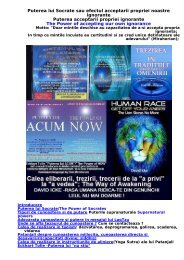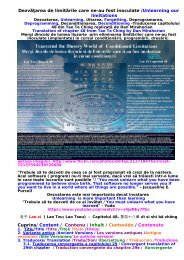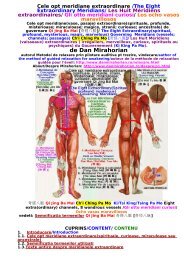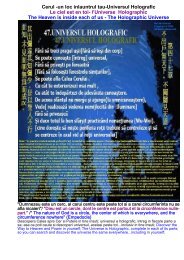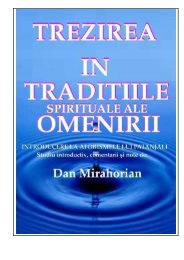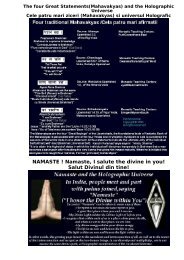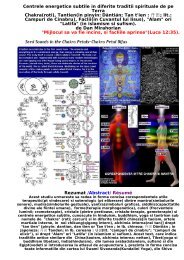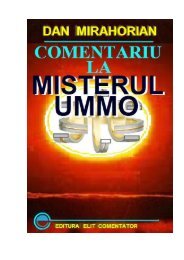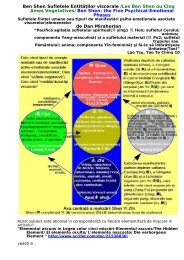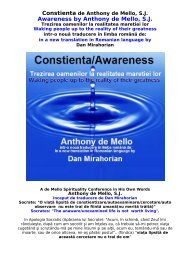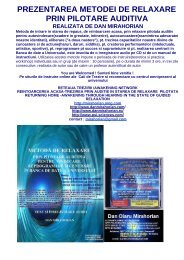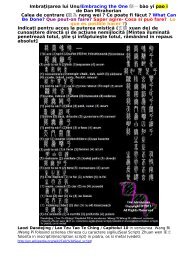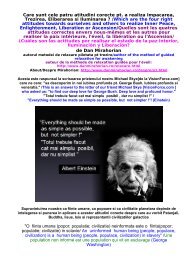äºè¡ææ¯å è¡ ? - Mirahorian
äºè¡ææ¯å è¡ ? - Mirahorian
äºè¡ææ¯å è¡ ? - Mirahorian
You also want an ePaper? Increase the reach of your titles
YUMPU automatically turns print PDFs into web optimized ePapers that Google loves.
Emotie<br />
furie<br />
anger<br />
bucurie<br />
joy<br />
(Exciteme<br />
nt<br />
concentrar<br />
e<br />
pensiveness<br />
Brooding<br />
suparar<br />
e<br />
sorrow<br />
frica<br />
fear<br />
--<br />
Anotimp<br />
primavara vara<br />
intersezon<br />
[sfarsit de<br />
vara]<br />
toamna iarna --<br />
Note<br />
muzicale<br />
Chueh<br />
(Mi)<br />
Chi(Sol)<br />
Kong(Do)<br />
Shang(R<br />
e)<br />
Yu(La)<br />
Chui is related to the kidney and the urinary bladder, its external sense<br />
organ is the ear and it emotion is fear. Xi regulates the triple warmer. The<br />
vibration of the six sounds clears the organs of stagnant energy and<br />
provides each organ with sufficient energy to optimize it functions and<br />
control its emotion and physical ailments. For example, some teachers<br />
suggest visualizations to accompany the sounds. Also, some of the<br />
teachers below (Cohen, Davis, and Reid) provide suggested movements to<br />
perform while making the sounds.<br />
The following table lists the sounds as explained by several teachers. The<br />
account given here is somewhat simplified. Six Healing Sounds<br />
The best known use of sound in Taoist practice appears to be the Six Healing<br />
Sounds, also known as the Six-Syllable Secret or the Six Basic Soundless Sounds<br />
for Health. Kenneth Cohen says the practice is attributed to a six-century<br />
Buddhist hermit. Craig Reid quotes a fifth century description of the system by a<br />
famous physician, Tao Hung-jing (perhaps the same as Cohen's hermit):<br />
One should take air in through the nose and let it out slowly through<br />
the mouth... There is one way of drawing breath in and six ways of<br />
expelling breath out. The six ways of expelling breath are<br />
represented by the syllables hsü, her, hoo, sss, chway, shee. The six<br />
ways of exhalation can cure illness: to expel heat, one uses chway; to<br />
expel cold, one uses hoo; to relieve tension, use shee; to release<br />
anger, use her; to display malaise, use hsü; and to regain equilibrium,<br />
use sss.<br />
The benefits described are thus more physical than spiritual per se, but to the<br />
extent that the Taoist tradition values balance and physical health, they could<br />
perhaps be considered a foundational practice for Taoist students. In comparison<br />
to Indian yoga techniques, the six healing sounds could be said to be more<br />
similar to pranayama than to mantra.<br />
In addition to the benefits listed previously, each sound is associated with an<br />
organ (sometimes more than one) and with a phase from the Five Phases system<br />
of Chinese metaphysics. Ni Hua-Ching states: "Each of the six vibrations has a<br />
psychic influence on its corresponding organ sphere which prompts the expulsion<br />
of impurities from the sphere and its manifestations, and the gathering of fresh<br />
energy into each system."<br />
Although a number of different modern masters teach the six sounds technique,<br />
there are differences, both small and large, in the sounds that they describe:<br />
The pronunciation of the sounds varies. Most of the apparent differences seem to<br />
arise from the difficulty of representing these sounds phonetically in print.<br />
Comparing the descriptions given by different teachers can help give you insight<br />
into the correct production of the sound. However, the sound for the kidneys<br />
really does vary significantly, and is given by different teachers as Foo, Chway,<br />
or Chrroooeee.<br />
The degree of vocalization varies. In many cases, the sounds are apparently<br />
just the sound of your breath exhaling, with such variations as can be caused by<br />
different positions of the tongue, lips, and teeth. However, some teachers<br />
pronounce some of the sounds as if they include a vowel, so the vocal cords in<br />
your throat are actively vibrating. Sat Chuen Hon vocalizes each of the sounds,<br />
which greatly shortens the consonant part of the sound the emphasizes the



